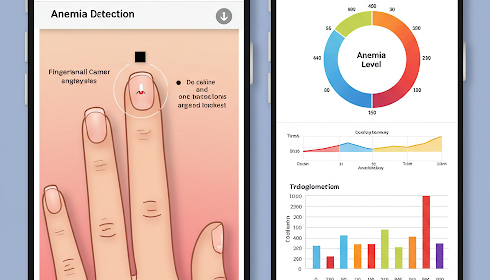
New AI App Detects Anemia Without a Drop of Blood
A new AI-based tool is revolutionising how millions of people may detect anaemia using only their smartphone cameras, bypassing standard lab testing— particularly in areas with limited medical access.
Anaemia, a disorder in which the body does not have enough healthy red blood cells to deliver oxygen, affects over 2 billion individuals worldwide. In the United States alone, nearly 83 million people are at high risk, with many requiring frequent monitoring. A breakthrough software powered by artificial intelligence (AI) promises to make anaemia screening more accessible than ever before using only a photo of your fingernail.
The study, published in the prominent journal Proceedings of the National Academy of Sciences (PNAS), describes how the app uses fingernail colour and texture to estimate haemoglobin levels, which are proteins in red blood cells that transport oxygen. The program captures the image with a smartphone camera and then interprets it using AI. To clarify: haemoglobin levels are an important sign of anaemia. Low haemoglobin levels indicate that a person may be anaemic.
More than 200,000 people have already used the software to do over 1.4 million tests. The app estimates haemoglobin with a margin of error of approximately ±0.72 g/dL. For mild-to-severe anaemia, haemoglobin levels above 10 g/dL improve accuracy to ±0.50 g/dL, comparable to routine lab tests.
Using the app on a regular basis improved test precision by nearly 50% for those with chronic anaemia, reducing the margin of error from ±1.36 to ±0.74 g/dL. This implies that patients can now manage their ailment at home, minimising the need for frequent and costly clinic visits.
Dr L. Andrew Lyon, a Chapman University professor and study co-author, emphasised the study's larger impact: "This research, more than eight years in the making, represents a meaningful step towards improving accessibility in healthcare... a commitment to empowering patients through innovation."
Another notable feature of the program is the ability to map anaemia incidences by location. By collecting anonymised location data, the research team built the first county-level map of anaemia in the United States, a tool that could assist public health officials in targeting interventions where they are most needed.
Traditional anaemia screening involves collecting blood and conducting lab tests, which is intrusive, expensive, and time-consuming. People in remote or underdeveloped areas may have difficulty accessing these tests. In contrast, our software provides a noninvasive, low-cost option that does not require any lab infrastructure. While not a replacement for medical diagnosis, it serves as an effective early warning system.
This breakthrough represents a bigger trend in healthcare: the use of AI and smartphone tools for truly life-saving applications, rather than merely convenience.